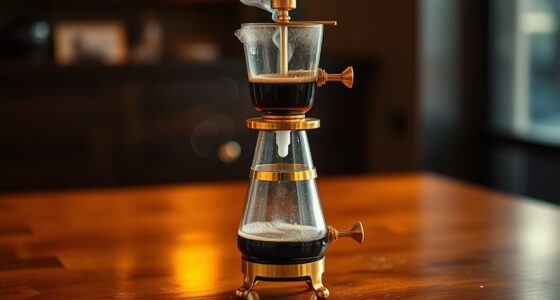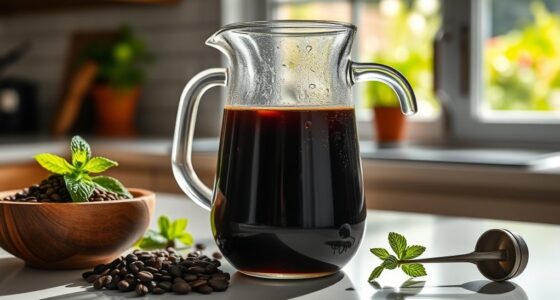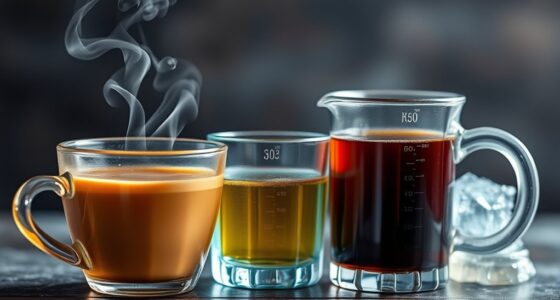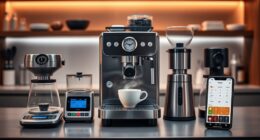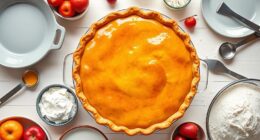Drip coffee brewing is all about filtering hot water through medium-coarse coffee grounds, giving you a clean, flavorful cup. You’ll need a quality coffee maker and a burr grinder for consistent grind size. Stick to a brew ratio of 1:17 for the best results, and make sure to use freshly ground beans for ideal flavor. Understanding your grind size and equipment can enhance your experience, and there’s so much more to explore in the world of drip coffee.
Key Takeaways
- Drip coffee involves water passing through a filter, producing a cleaner cup compared to immersion methods.
- Use medium-coarse grind for optimal extraction, aiming for a brew ratio of 1:17 (coffee to water).
- Essential equipment includes a coffee maker, burr grinder, kitchen scale, and pour-over brewer for better control.
- Freshly ground whole bean coffee enhances flavor; store beans in an airtight container in a cool, dark place.
- Light and bright coffees are best brewed with drip methods, while heavier coffees suit immersion techniques like French press.
Understanding Drip Coffee
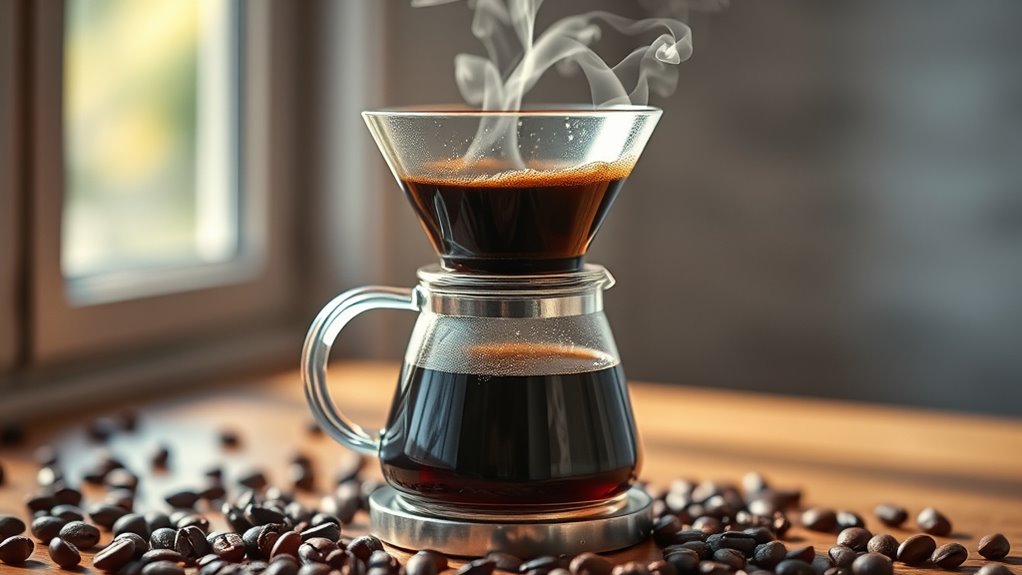
When you hear the term “drip coffee,” it often conjures images of hot water cascading over coffee grounds, but it can mean different things in various contexts.
This brewing method typically involves water passing through a filter, resulting in filtered coffee that’s loved for its cleaner cup. While automatic machines are common, manual coffee methods like pour-over also fall under the drip coffee umbrella.
The grind size of your coffee grounds plays a critical role in the brew process, affecting extraction and flavor. Drip coffee usually offers a lighter body compared to immersion methods, which produce a full-bodied cup of coffee.
Understanding these nuances can enhance your coffee experience, so be clear when ordering your preferred style.
Brewing Methods Comparison

Drip coffee is just one of many brewing methods available, each offering unique characteristics that cater to different preferences.
The drip method, also known as filter coffee, involves hot water passing through a medium-coarse grind of coffee grounds, ensuring ideal extraction. While automatic machines provide consistency in the brewing process, manual pour-over allows you to control brewing variables like water temperature and pour rate, influencing flavor.
The drip method, or filter coffee, offers a balanced extraction through controlled brewing variables, enhancing flavor with every cup.
Compared to immersion methods like French Press, drip coffee yields a cleaner cup with less body.
For the best results, stick to a traditional brew ratio of 1:17—one gram of coffee for every 17 grams of water. This balance helps achieve the perfect extraction for a satisfying cup.
Essential Equipment for Drip Coffee
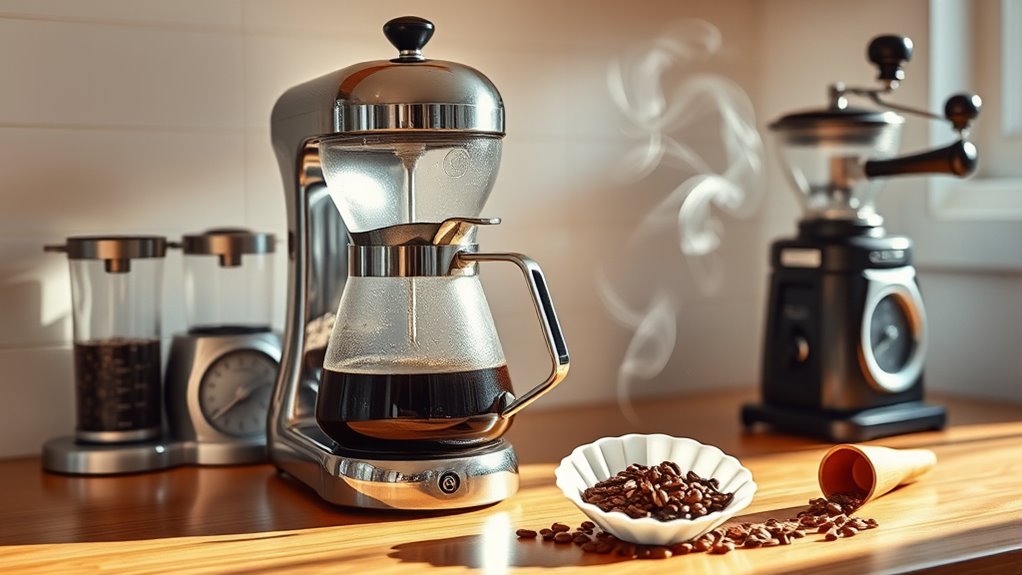
To brew a delicious cup of drip coffee, you’ll need some essential equipment that enhances the process. Start with an automatic coffee maker or a manual pour-over brewer, both designed for hot water to pass through coffee grounds effectively. A quality burr grinder is vital for a uniform grind size, while a kitchen scale guarantees you hit the right coffee-to-water ratio of 1:17. If you’re using a pour-over brewer, a slow-pouring kettle allows for better control over extraction time. Finally, opt for a thermal carafe to keep your coffee hot without risking bitterness. Here’s a quick reference table:
| Equipment | Purpose | Notes |
|---|---|---|
| Coffee Maker | Brew drip coffee | Automatic or manual |
| Burr Grinder | Achieve consistent grind size | Baratza Encore recommended |
| Kitchen Scale | Measure coffee accurately | Ideal coffee-to-water ratio |
| Pour-Over Brewer | Control brewing process | Requires slow-pouring kettle |
| Thermal Carafe | Keep coffee hot without burning | Prevents over-extraction |
Grinding and Freshness

Freshly grinding your coffee beans just before brewing is essential for revealing the full spectrum of flavors. When you grind your beans, you release aromatic oils that enhance the taste of your coffee.
For drip coffee, aim for a medium-coarse grind, resembling sand, to guarantee consistent extraction during brewing. Using a burr grinder is recommended, as it provides a uniform grind size compared to a blade grinder.
Opt for whole bean coffee to maintain coffee freshness, since pre-ground coffee loses flavor quickly due to oxidation. To keep your beans fresh, store them in an airtight container in a cool, dark place, protecting them from light, heat, and moisture.
This way, you’ll enjoy a richer, more flavorful cup every time.
Flavor Profiles and Pairings
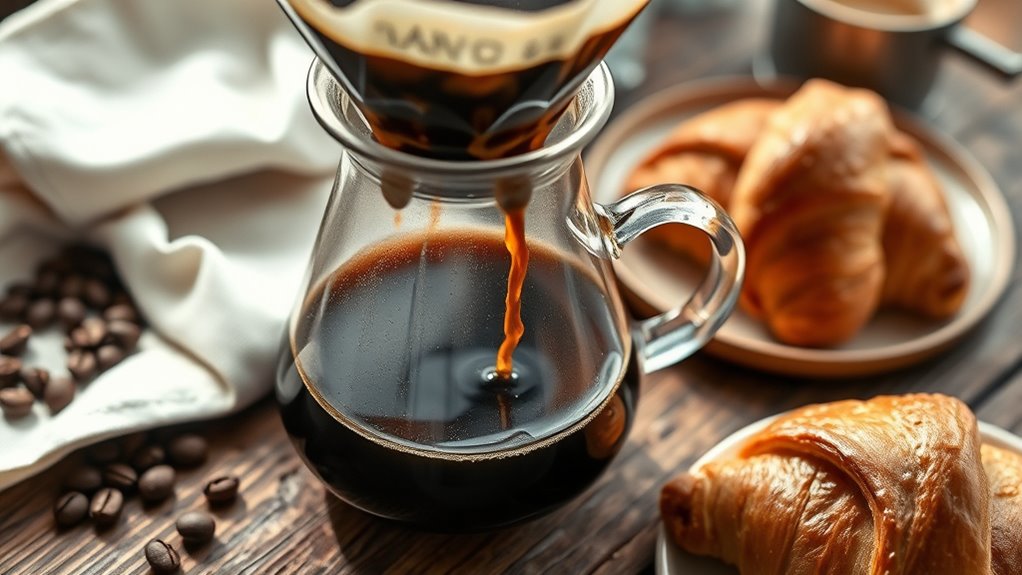
Understanding the nuances of coffee flavor profiles can elevate your brewing experience significantly.
Light and bright coffees, with their fruity and floral notes, shine when brewed using pour-over methods, enhancing their subtle flavors. On the other hand, heavy and rich coffees often feature chocolatey or nutty profiles and thrive with immersion methods like French press or espresso, emphasizing their fuller-bodied characteristics.
When experimenting with different brews, remember that fruity flavors can clash with thicker textures, so opt for cleaner methods. Additionally, avoid pairing tea-like textures with dark chocolatey flavors, as this can unbalance your taste experience.
Frequently Asked Questions
What Are the 3 Phases of Drip Coffee Brewing?
When brewing drip coffee, you’ll experience three key phases.
First, there’s the pre-wet phase, where you saturate the coffee grounds to bloom and release carbon dioxide.
Next, in the brewing phase, hot water extracts the flavors from the grounds, ideally between 195°F and 205°F.
Finally, the brewed coffee drips into the carafe, completing the extraction.
Each phase is essential for achieving that perfect balance and flavor in your cup.
What Is the 80/20 Rule for Coffee?
Think of coffee like a symphony; the 80/20 rule suggests that just a few high-quality notes create an unforgettable melody.
This principle states that 80% of your coffee’s flavor comes from just 20% of the grounds used. By focusing on selecting premium beans and the right coffee-to-water ratio, you’ll elevate your brew’s flavor.
How Do You Make Drip Coffee Step by Step?
To make drip coffee, start by measuring about 20 grams of medium-coarse coffee grounds for every 320 grams of water.
Use cold-filtered water heated to 195°F to 205°F.
Place a coffee filter in the machine’s basket, add the grounds evenly, and pour the hot water into the reservoir without exceeding the fill line.
Start the brewing cycle, and once it’s done, let it sit briefly before pouring and enjoying your coffee.
What Are the Fundamentals of Coffee Brewing?
Brewing coffee is like painting a masterpiece; each brushstroke matters.
To brew well, you need the right coffee-to-water ratio, typically 1:17, ensuring rich flavor without bitterness. Use a medium-coarse grind for balance, and keep your water temperature between 195°F and 205°F for ideal extraction.
Preheating your equipment creates a cozy environment for flavor to bloom. Attention to these fundamentals transforms your coffee from mere beans to a warm hug in a cup.
Conclusion
In the world of drip coffee, you’ve discovered the art of brewing, embraced the right equipment, and appreciated the importance of freshness. You’ve learned to explore flavor profiles, pairing your favorite beans with delightful treats. Now, as you savor your perfect cup, you’re not just drinking coffee; you’re enjoying a ritual, experiencing a moment, and celebrating the simple pleasure of each sip. So, go ahead—brew, taste, and cherish your daily cup of joy.



